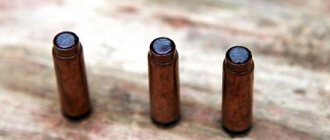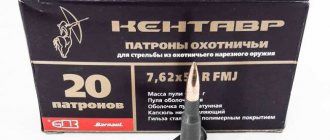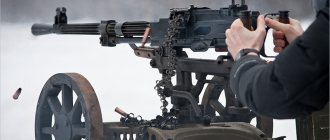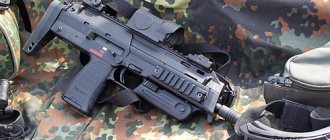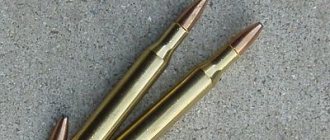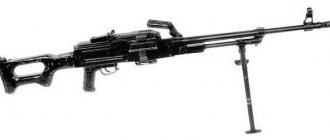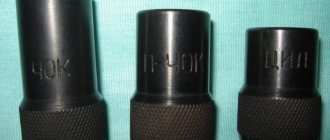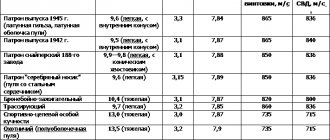Hello, dear hunting lovers! Today we will talk about Polev’s bullets. Yes, that's right, the stress falls on the second syllable. Many people are confused about the correct pronunciation of the name of these bullets. So, the topic of conversation is the Polev 12-caliber bullet, its variety and the possibility of their use in various conditions.
He invented his first bullet in the distant 1980s, Viktor Vladimirovich Polev (interview with him). The reason was the lack in the Soviet Union of good, high-quality bullets for smooth-bore weapons capable of accurately hitting a target at a distance of more than 50 meters.
This is how the Polev 1 bullet was created.
Bullet Polev 1
It is a pointed lead head weighing 30 + - 1 g. It was distinguished from an ordinary bullet by the presence of a wad - a stabilizer, a kind of shank attached to the bullet itself, which served both as a wad in the cartridge and as a stabilizer during the flight of the bullet. This shank had grooves made by a screw. As a result, the bullet spun when fired.
An important fact was that the bullet was in a kind of container, which consists of two halves and is separated when it leaves the barrel. Then the bullet flies, resembling a rocket with stabilizers. This allows you to shoot a Poleva-1 bullet with almost any choke, including a reinforced choke.
All these facts could not but affect the high flight range and accuracy of hits.
Due to the fact that the bullet turned out to be quite heavy, shooting from some double-barreled shotguns differed from the declared characteristics for the worse. This was due to the fact that with double-barreled shotguns, the bullet flies from each barrel at a different angle, and the greater the mass of the bullet, the higher the difference in its flight trajectories. On these grounds, conclusions were drawn, and a second version of this bullet was created.
Cartridge with a sub-caliber feathered bullet for smooth-bore hunting rifles
So, from the very beginning. I am not a hunter, although, as a student at the weapons and machine gun department of the Tula Mechanical Institute, I took a course in hunting weapons and practice at the glorious Tula Arms Factory. Moreover, I have a negative attitude towards killing animals, but I am aware that this is just my personal opinion, with which many will not agree. Among them was my uncle, a retired colonel and a passionate hunter.
Knowing that I worked in the ammunition field, he asked me to make him a device for casting Mayer bullets. They had just received a glowing review in Hunting and Game Management magazine, and were hard to find for sale. Using the provisions of external ballistics, I tried to explain to him that none of the known hunting bullets can be stable on the trajectory and have tolerable accuracy for the simple reason that they do not have effective elements of gyroscopic or aerodynamic stabilization. And Mayer's bullet as well. As arguments, I referred to the shapes of mortar shells and other smooth-bore projectiles. But I was told not to be clever and to carry out the order. I didn’t dare contradict my uncle.
It so happened that at one of the meetings at the ministry, I, sitting in the back row, had a conversation on an abstract topic with the leading developer of sub-caliber finned anti-tank shells for smoothbore guns. In my hands I turned over the recently cast Mayer bullet. Having become interested in the toy in my hands and having received an explanation, my interlocutor expressed surprise: “Can this chimera really fly normally?” We agreed that, of course, not, but hunters are helped by the fact that they hit the animal almost point-blank, and the very low muzzle pressure during the shot does not lead to large disturbances that can throw the bullet off balance.
At the same time, we came to the conclusion that God himself ordered the experience of developing smooth-bore artillery shells to be used for hunting bullets. After all, serious progress had just been made in anti-tank artillery after the transition from a rifled barrel to a smooth one: the new (at that time) smooth-bore hundred-millimeter “Rapier” significantly surpassed the D-44 cannon, famous in the war, with a rifled barrel of the same caliber. Obviously, this advantage should also be true for smooth barrels of hunting rifles. The point is small: this experiment was then classified as top secret. It was necessary, using the idea of a combat projectile, to transform the design so that it did not contain secret elements, even at the expense of deteriorating relative characteristics.
This was not a big deal, since at that time I was just developing sub-caliber feathered ammunition for small arms. I completed the calculations and preliminary design of the 12-gauge finned sub-caliber bullet in a few days. The only “little” thing left was: who will allocate funds for an experimental test?
Quite unexpectedly, I received moral and material support from a close friend and comrade from my institute days, Viktor Shipilov. In principle, he, being a certified gunsmith, specialized in testing aircraft guns, but by the will of his superiors he was transferred to the leadership of the State Testing Station for Hunting and Sports Weapons and Ammunition.
This position, in addition to direct supervision of tests, was associated with the need to communicate with representatives of a wide variety of institutions, factories and departments, including frequent trips abroad. Prominent in appearance and sociable in character, Victor was better suited to this position than anyone else. I'll give just one example. Everyone knows the excellent TOZ-34 double-barreled shotgun of the talented Tula instructor Korovyakov. And this gun would have been in the general ranks of other equally little-known Tula and Izhevsk developments if Victor had not been able to present it at the Brussels exhibition in such a way that even the European Commission, which was slow to recognize Russian merits, unanimously awarded the TOZ-34 a gold medal.
Unfortunately, Viktor Vasilyevich will not read these lines - in the prime of his life he was destined to end his life’s journey.
Shipilov immediately understood the advantages of the proposal and unquestioningly signed an order for the production of a pilot batch of ammunition. It did not require too much knowledge of internal ballistics to foresee the difficulties awaiting us. For example, there was no confidence that standard gunpowder would allow a normal shot. Further, even preliminary calculations showed that colossal overloads would make one wonder about the strength of the bullet elements, etc. and so on. Therefore, in the first batch of cartridges (of only twenty pieces), the bullets were made of steel with milled stabilizers. Just in case, I hardened the bullets to approximately 60 Rockwell hardness.
The selection of the charge was carried out by firing from a ballistic barrel and measuring the pressure of the powder gases with a crusher device. Since it was a pity to waste the bullets we had hard-earned for this purpose, shot shells of the same weight were used to select the charge.
As is usual in experimental work, the worst assumptions are always justified. So it is here: the standard Sokol, P-45, P-85 and even P-125 gunpowder did not burn normally. The shot was weak. But this first obstacle was overcome, and we came to the ballistics laboratory of our colleague Nikolai Nikolaevich Averin to measure the initial velocity with cartridges that, under normal conditions, provided an average intra-ballistic pressure of 600 kg/cm2.
According to safety regulations, as well as during the preliminary selection of the charge, the shooting was carried out from a durable ballistic barrel with a remote shot fired. This measure was far from superfluous, since, by forcing the initially weakly burning charge, we came across high pressures of up to 1200 kg/cm2. Here a passage awaited us - after the first shots and measurements of the initial speed, Nikolai Nikolaevich suggested that we stop shooting. It turned out that hardened experimental bullets, weighing 14 grams, at an initial speed of 600 m/s, pierced a 10-mm armor plate on which inertial sensors were attached. We were not particularly upset - the results showed the feasibility of further expansion of work.
At the second stage, it was necessary to test a real hunting bullet - a semi-jacketed one, to ensure proper lethality and obtain good accuracy.
When testing the semi-jacketed bullet, we had to tinker with the strength of the shell, since at first, due to colossal overloads, the bullet was deformed while still in the barrel. You couldn’t expect good accuracy if you didn’t make the bullets turn on the trajectory. This rotation averages the eccentricity of the total component of the aerodynamic drag forces. Otherwise, this component simply moves the projectile to the side.
There is a classic example of the benefit of turning aerodynamically stabilized projectiles on a trajectory. This is the famous "Katyusha". The first versions of its missiles, the M-13, did not turn on the trajectory and had such a spread that a salvo from the launcher could guarantee coverage of a target no smaller than a village. After the M-13 VK rotating missiles were tested at the suggestion of our scientists, a salvo of several such missiles ensured the destruction of a tank company.
We ensured the rotation of our bullets constructively - due to the bevel of the tail. However, seeing in practice the relationship between the bevel size and the rotation speed turned out to be quite troublesome. For this purpose, at a short distance from each other, we installed a number of frames with calcined Whatman sheets, on which the holes were so clear that the dynamics of rotation and vibration of the bullets could be determined with satisfactory accuracy. We carried out these shootings on an open track 200 meters long. Of course, sometimes we had to wait for good weather. For a computational analysis of the capabilities of the new bullets, it was necessary to determine its shape coefficient (ballistic coefficient). This was done in two ways: either by processing the bullet speed determined at two sections of the 200-meter distance, or by using the initial speed and flight time over the full distance.
In short, all the results we obtain would be more than enough to write a dissertation.
We received significant help after Nikolai Terekhov, a graduate of the Tula weapons department, appeared in Viktor Vasilyevich’s department. He was ordered to complete a thesis on this topic and then take over all work with sub-caliber ammunition. Nikolai had the title of Master of Sports in shooting, so the results he presented regarding the accuracy of shooting with real ammunition did not raise any doubts.
In the end, for full-scale testing in protected hunting grounds, a version of the 12-gauge cartridge in a folder sleeve was tested, with a 6.8 mm bullet, with a flight weight of 12.2 g, which had an average initial speed of 573 m/s. The dispersion diameter at a distance of 100 meters was: the best - 100 mm, the worst - 150 mm. The ballistic coefficient according to Siacci's law of drag was 4.7. The average maximum pressure did not exceed 650 kg/cm2. The powder charge consisted of a 2.3 g sample of Sokol gunpowder. However, normal functioning of the charge was ensured only if a special primer was used.
Tests in the Azov-Sivashsky protected hunting area on Biryuchiy Island were indicative. As an eyewitness described it, at first the ironic smiles of the village rangers were caused by the appearance of the capital’s “dudes” in hats and with optical sights on shotguns. But this was only before the deputy director of the farm led the entire group to the herd of deer. Pointing to one of the discarded deer, he put his hand to the optical sight of the 9 mm self-loading carbine “Bear”, but did not dare to shoot, making the excuse that the distance was long and he was afraid of making a wounded animal. After a moment of thought, Nikolai Terekhov asked permission to fire a sub-caliber bullet from his gun - he had a 12-gauge MTs-9 custom-made sideflint gun with a PO-10-1 sight, manufactured by the Tula TsKIB-SOO.
The deer collapsed as if knocked down. Scrupulous measurement of the distance allowed us to record a range of 300 meters! The second shot was fired with equal success from a distance of 280 meters. After this, it was decided that these two results were enough for the record and that in the future it would not be worth shooting from such distances.
I only once participated in full-scale tests together with Shipilov in the Krolevets nature reserve in the Sumy region in Ukraine. The tests there were supervised by the head of the Sumy hunting management department, Vladimir Viktorovich Kushnirenko. To me, inexperienced in the wisdom of hunting, he seemed like Fenimore Cooper's St. John's Wort, but only with a higher education. I had a separate task, I had to evaluate the effectiveness of the English Single Point dot sight when installing it on a shotgun. At the same time, I tested a variant of a sub-caliber cartridge with an 8 mm bullet. This bullet weighed 19 g and functioned well with the standard load of Sokol gunpowder. Its average initial speed was 490 m/s. Its accuracy was worse than that of the first version of 6.8 mm caliber. The best dispersion diameter at a distance of 100 meters was 200 mm, the worst was 300 mm.
It was precisely this bullet and with a Single Point sight from a distance of 150 meters that Vladimir Kushnirenko forced me to shoot at a young elk. I later shot at a wolf that the huntsmen had sent out at me, but not entirely successfully - I finished off the wolf Kushnirenko. The head of hunting farms of Ukraine, Boldenkov SV, came to us for testing. he jokingly awarded me a medal with a picture of a wild boar.
The history of the creation of this still unknown cartridge goes back thirty years. Once upon a time I wanted to publish this story in the magazine “Hunting and Game Management”. A detailed article was sent to the editor outlining the results of ballistic calculations, laboratory testing and field tests. But at that time, the magazine did not dare to publish this, which was notified to me in writing by one of the editorial staff, by the way, a friend of my youth. And on the copyright certificates issued to me, although not secret, it was stated: “not subject to publication in the open press.” Now the time is different.
EXTRACT FROM THE OFFICIAL REPORT OF TSNIITOCHMASH
1. The proposal for the use of cartridges with sub-caliber bullets in smooth-bore hunting weapons appeared as a result of theoretical conversion studies carried out by the developers of sub-caliber ammunition for small arms and cannon weapons at the Central Research Institute (TsNIITM) in Klimovsk, Moscow Region in 1967. If the practical solution to this problem is successful, conventional shotguns could compete with expensive rifled weapons. The first experimental test of the proposal was carried out on the track of the TsNIITM ballistics laboratory on twenty pieces of experimental bullets manufactured in the pilot production of the TsNIITM and loaded into 12-gauge folder cases. The accuracy of the bullets was checked while simultaneously selecting the charge. The shooting was carried out from a ballistic crushing barrel with measurements of the crushing pressure and the initial velocity of the bullets.
2. The first official proposal of such a cartridge was the author’s application No. 1136908 with priority dated February 27, 1967, issued by the author on the basis of a positive result of the check under paragraph 1. Based on this application, copyright certificate No. 239074 dated December 18, 1968 was issued.
3. Further studies of sub-caliber hunting bullets were carried out at the Central Research Institute of Technology under the state budget topic NG-10-44549.
4. The first official test of sub-caliber feathered hunting bullets in natural conditions was carried out in the Krolevets hunting estate of the Sumy region of the Ukrainian SSR on the basis of a program agreed upon on August 28, 1969 with the head of the Main Directorate of the Hunting Estate of the MLX USCP and approved on October 23, 1968 by the chief engineer of the TsNIITM.
5. Tests of various designs of sub-caliber hunting bullets, equipped with 12-gauge folder casings, for their lethality and firing range from smooth-bore guns equipped with optical sights, in particular, were carried out in the following hunting grounds:
20.1.1969. Mahtrakh forestry enterprise of the Estonian SSR. A boar weighing 140 kg was killed with the first shot.
6.10.1969. Nalchik State Forestry Farm. One boar. Killed with the first shot.
10/13/1969. Sumy Regional Department of Forestry and Logging. 2 moose. One from the 1st, the second from the 3rd shots. One roe deer from the first shot and one fox from the first shot.
12/29/1969. Right there. Five moose, one wild boar, two roe deer. All from the first shot.
1.1.1970. Sosnovskoe state forestry and hunting enterprise, Leningrad region. Two deer and one elk - from the first shot. One elk - from the second shot.
26.2.1970. Azov-Sivash reserve and hunting area (Viruchiy island). Tests on the firing range of sub-caliber bullets and lethality. Seven deer were killed at distances of 200,150, 200, 280,160, 280 and 300 meters. Of these, six were killed with the first shot and one with the second.
10/14/1970. Sumy Regional Department of Forestry and Logging. Eight moose. Of these, seven were from the first shot and one from the second.
12.4.1970. Oka State Nature Reserve, Ryazan Region. Three boars. All from the first shot.
15.3.1970. Azov-Sivash reserve and hunting area. Five deer were killed. Of these, two were from the first shot and three from the second shot.
6. Hunting cartridges with a sub-caliber feathered bullet were manufactured only at TsNIITM and only in small (no more than a few dozen) batches for 12-gauge shotguns. Larger batches were not produced, but design work was carried out towards the development of new samples. The cartridge was named “Zenith.
Dmitry Shiryaev Hunting and Fishing XXI century 7-2003
Bullet Polev 2
It is much narrower and longer than its predecessor. Her weight was 28 grams. Also new were the separable wad and stabilizer - it began to be a shank with six blades.
Due to the fact that the weight was reduced, the projectile's flight speed began to be 450 m/s.
The bullet turned out to be very accurate. During factory tests, the spread at 100 meters was 8 cm, and at 200 meters - 20 cm. This was a very good result for a smooth-bore weapon!
Zeroing Vepr 12 Hammer with this bullet:
But both the first bullet and the second had one significant drawback. They had a fairly low stopping effect.
Often, when fired, the bullet missed the animal, and the animal continued to run further. To eliminate this drawback, Polev will improve his bullet and get a third option.
Literature
- Shirokorad A.
God of War of the Third Reich. - M.: AST, 2003. - Karman U.
History of firearms. - M.: Tsentrpoligraf, 2006. - Kozyrev M., Kozyrev V.
Unusual weapons of the Third Reich. - M.: Tsentrpoligraf, 2008. - 399 p. — ISBN 978-5-9524-3370-0; BBK 63.3(0)62 K59.
- Hogg Y.
Ammunition: cartridges, grenades, artillery shells, mortar shells. - M.: Eksmo-Press, 2001. - Irving D.
Weapons of Retribution. - M.: Tsentrpoligraf, 2005. - Dornberger V.
V-2. - M.: Tsentrpoligraf, 2004. - Katorin Yu. F., Volkovsky N. L., Tarnavsky V. V.
Unique and paradoxical military equipment. - St. Petersburg: Polygon, 2003. - 686 p. — (Military History Library). — ISBN 5-59173-238-6, UDC 623.4, BBK 68.8 K 29.
Bullet Polev 3
In terms of its characteristics, it is completely identical to the second. But there was one difference - an expansive funnel
.
This is a recess at the end of the lead head. That is, we have a truncated cone, and instead of a flat area at the tip there is a depression inside the bullet.
The innovation worked as follows: the bullet, touching the body of the animal, began to “open up,” thereby increasing the area of contact with the animal. The stopping effect was excellent. But many hunters noted large hematomas on the body of the killed animal.
Everyone has a choice - either shoot accurately or stop. The flight characteristics remained practically unchanged, the only thing was that the bullet's flight speed decreased slightly.
Armor penetration indicators
Comparative assessment of armor penetration indicators is associated with significant difficulties. The assessment of armor penetration indicators is influenced by rather different methods of testing BOPS in different countries, the lack of a standard type of armor for testing in different countries, different conditions for placing armor (compact or spaced), as well as constant manipulations by developers of all countries with firing distances of the armor being tested, angles of installation of the armor before testing, various statistical methods for processing test results. Homogeneous rolled armor is accepted as a material for testing in Russia and NATO countries; composite targets are used to obtain more accurate results.
According to published data [ source not specified 644 days
], increasing the elongation of the flight part to a value of 30 made it possible to increase the relative thickness of the pierced rolled homogeneous armor of the RHA standard (the ratio of the armor thickness to the caliber of the gun, b/dп) to the following values: 5.0 in 105 mm caliber, and 6.8 in 120 mm caliber .
Russia
- BOPS Svinets-1 3BM59
- not announced, but since a projectile with a uranium core, compared to a tungsten one, has approximately 15-20% greater armor penetration, you can compare this projectile with the Svinets-2 3BM60 projectile to calculate that it has an armor penetration of about 700 mm / 0° and 350 mm/60°; available for the latest modifications 2A46. - BOPS Svinets-2 3BM60
– 600 mm/0°, 300 mm/60°; available for the latest modifications 2A46. - BOPS Mango-M
– 280 mm/60°, available for all modifications of 2A46. - BOPS Vacuum-1
– 900/0°; for the 2A82 gun. - BOPS lead
more than 1000 mm
a number of other US
- BOPS M829A1
for a 120 mm caliber gun (USA) - 700 mm; - BOPS M829A2
- 750 mm; - BOPS M829A3
- 800 mm; often mentioned over the years “800+” - M829A4
BOPS has not been announced; outwardly it is quite consistent with its predecessor. Referring to the words of the developer, they call it 770.
Germany
BOPS DM53 for the Rheinmetall L/55 cannon of 120 mm caliber with an increased barrel length Lstv = 55 klb. — 750 mm (D=2000 m). Projectile length 740 mm, diameter 22.7 mm, head length 84 mm (total from the end of the core to the beginning of the head 656 mm), weight about 5 kg.
Of the known BPS of other countries, no record-breaking ammunition has been observed in recent decades, which has little to do with the actual state of the situation, especially in the sense of additional data (for example, the number of shells and guns and the security of the carrier).
Poleva Bullet 6
Quite recently, the Polev-6 bullet appeared.
In appearance, this 12-caliber field bullet is more reminiscent of the first variety, but in terms of its features, it resembles the third. It also has an expansive funnel. Its weight was 33 grams, which allows us to draw conclusions that it is better to use it on single-barreled shotguns. There is also a “magnum” version weighing 40 grams.
All bullets with an expansive funnel had a rather significant drawback - they ricochet very strongly.
This is due to the fact that during flight the bullet can touch some obstacles: grass, branches, etc., and upon contact with them it begins to open up, which changes its aerodynamic characteristics, and it begins to change direction unpredictably.
It is very dangerous because you cannot guess the direction of the flight.
story
Steel plates penetrated in tests by naval artillery, 1867
The late 1850s saw the development of the ironclad warship, which carried wrought iron armor of considerable thickness. This armor was virtually immune to both round cast iron cannonballs in use and to the newly developed explosive casing.
The first solution to this problem was carried out by Large Sir W. Palliser, who, with the Palliser shot, invented a method of hardening the head of a pointed cast iron shot. By casting the projectile point downwards and forming the head in the iron mold, the hot metal suddenly cooled and became very hard
(resistant to deformation through martensitic phase transformation), while the rest of the press - molds, are formed from sand, allowed the metal to cool slowly and the body of the shot to be
rigid
(resistant to crumbling).
These cooled iron shots proved very effective against wrought iron armor, but were not effective against compound and steel armor, which was first introduced in 1880. A new offset, therefore, had to be made, and forged steel rounds with water-hardened points take the place of the Palliser shot. At first, these forged steel rounds were made from ordinary carbon steel, but as armor quality improved, the projectiles followed suit.
During the 1890s and thereafter, steel armor became common, initially only on thicker armored ships. To combat this, the projectile was made from forged or cast steel containing both nickel and chromium. Another change was the introduction of a soft metal cover over the point of the shell - the so-called "Makarov Soviets", invented by the Russian admiral Stepan Makarov. This "cap" increased penetration by softening some of the impact of shock and preventing the armor-piercing point from being damaged before it struck the armored face or body shell from breaking. It can also aid penetration at an oblique angle, keeping the point from veering away from the face armor.

